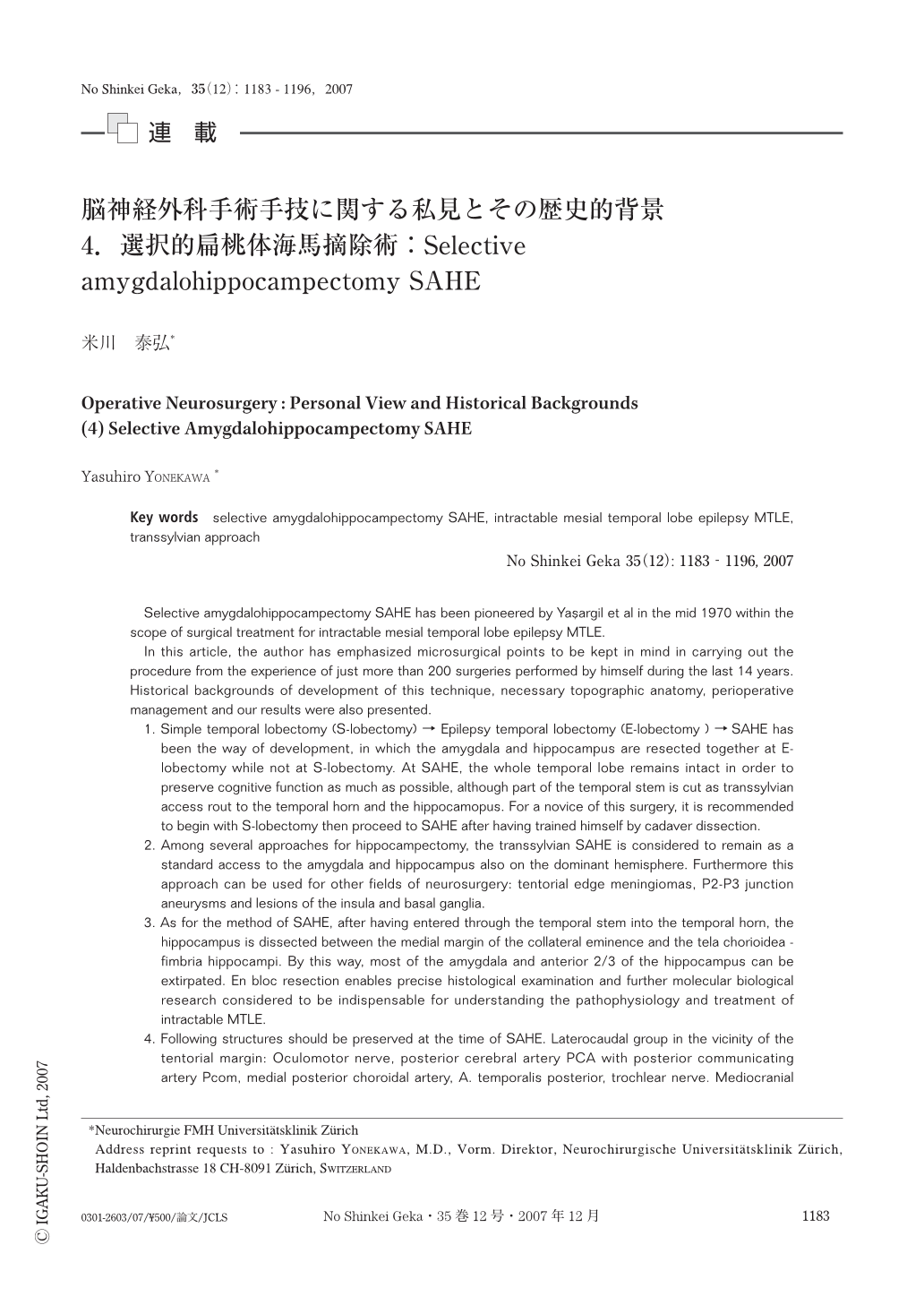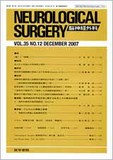Japanese
English
- 有料閲覧
- Abstract 文献概要
- 1ページ目 Look Inside
- 参考文献 Reference
Ⅰ.はじめに(Fig. 1)
1970年代中ごろにここZuerichでselective amygdalohippocampectomy SAHEがProf. Yaşargilら22,24,25,27)によって開発された当時,私はstaffとしてそのZuerichに勤めていたのであるが,蒙昧にしてその重要さを知らなかった.この術式の開発された由来は,当教室で初代Prof. Krayenbuehlの時代から重点を置いて行われてきたepilepsyに対する外科的治療にある.Epilepsy surgeryとしてのtemporal lobectomyをさらに進めた形で,SAHEは薬剤抵抗性mesial temporal lobe epilepsy MTLE治療の完成した形として定着した.Lobectomyによるcognitive functionの低下を防ぐために,selectiveにAmygdala,Hippocampusを切除するものである.
こちらに1993年に着任して,まず途方にくれたのはこの手術であった.自分では十分にHippocampusを取り出したつもりでも,術後のCTをみて,minihippocampectomyに落胆したものである.またその摘除したHippocampusのvolumeが少なかったために,epilepsyが再発し再手術を余儀なくされた例が数例ある.他の大学病院の有名なbossが行ったhippocampectomyが不十分であったために当方で処理した例も何例もある.EpileptologistのProf. Wieserに励まされて,なんとかできるという感触が得られるようになったのは,それから数年経って30~40例を行ってからである.この手術ができるようになってから他の脳神経外科の手術を行う際にapproachを選択するにあたって,大きな幅ができたように思う.それはこのapproachがHippocampusのみでなく,テント切痕近傍の病変(テント切痕meningioma,P2-P3 junction aneurysmなど)にFissura chorioideaを介して,それほどのretractionなしに到達できるからである.また,insular lesion,basal ganglia lesionの扱いにも,大きな余裕ができたと思う.Temporal hornに到達するために古くはNiemeyerのtransventricular amygdalohippocampectomy 17)を始め近年もこれに準じた種々のapproachが考案され発表されている9,15,19,22).Transsylvian SAHEではtemporal stem をせいぜい1.5~2.0cm切断するということについて,そのhandicapが強調されている19)が,実際にその切断に起因する弱点が高度のmicrosurgical techniqueを必要とすることのほかにあるのか,あるとすればどのあたりにあるのかをきちんと述べていると思える論文はない.私の考えでは,Amygdalaを可及的に切除し,HippocampusとGyrus parahippocampalisを必要に応じてできるだけ,後方まで切除する方法として,このapproachはスタンダードなものであり続けると考える.
この手術の難易度についてであるが,深さと,狭い視野で手術をすること,摘除すべきhippocampal formationをsupplyする血管をすべて凝固切断する必要があること,またAchoA,Tractus opticus,Crus cerebri,Oculomotorius,PCA,Trochearisなどを損傷せぬように気をつけることなどの点を考慮すると,extrameatal 2~3cmの径の聴神経腫瘍の手術に匹敵するのではないかと思いProf. Yaşargilに私の感想を申し上げたところ,彼からも同意を得た.
Guitaristとして演奏中にてんかんが起こって演奏ができなくなり,音楽家としての活動ができなくなった人が,再び舞台にあがることができたとか,ダンプカーの運転手が再び運転できるようになったとか,建築作業の最前線で働いている人が,ふたたび高い架台に上って作業できるようになったとか,学生が発作に悩まされることなく,学業に専念できるようになったとかという喜びの手紙をもらっている.またそのてんかんの日々から生還しその喜びを単行本の形で表し,病める人の啓蒙に勤めている元患者さん2)を観るにつけ,日本でも真柳先生らの先駆的な仕事13)があるが,この手術がもっと普及してもよいと思う.
かつて1990年代の半ばごろに,大学時代の同級生の麻酔医の加藤浩子先生(元神戸中央市民病院副院長)に「貴方ねー,Amygdala,Hippocampusみたいな大事なstructureを,てんかんがあるからといって取ってしまってどうするのー」と軽蔑するように,質問されたことがあった.LeDouxの“Synaptic self” 11)にもあるように,そのころよりもAmygdala,Hippocampusの機能がもっと分かってきている今日,身にしみて理解できる卓見であった.私はこの手術をするようになって,上述のように技術的なことで幅ができたと感じたほかに,記憶,意識,感情など人間の根源的ないとなみについて,てんかん発作の症候発現との関連で,神経解剖から生理学にまで考えをめぐらせる機会を得ることができたのは僥倖であった.そのとき加藤先生には,その大切な機能に寄与する本来の組織がこれらの患者さんでは変性してほとんど不要になっているので,摘除しても日常生活には支障を来さない旨のことを答えたのを思い出す.
ただ,以来200例以上この手術を経験したが,この手術がなんとかできるようになったのは脳血管外科医として脳血管を手術用顕微鏡下で扱うことに慣れていたことにもよると思う.
Selective amygdalohippocampectomy SAHE has been pioneered by Yaşargil et al in the mid 1970 within the scope of surgical treatment for intractable mesial temporal lobe epilepsy MTLE.
In this article, the author has emphasized microsurgical points to be kept in mind in carrying out the procedure from the experience of just more than 200 surgeries performed by himself during the last 14 years. Historical backgrounds of development of this technique, necessary topographic anatomy, perioperative management and our results were also presented.
1. Simple temporal lobectomy (S-lobectomy) → Epilepsy temporal lobectomy (E-lobectomy ) →SAHE has been the way of development, in which the amygdala and hippocampus are resected together at E-lobectomy while not at S-lobectomy. At SAHE, the whole temporal lobe remains intact in order to preserve cognitive function as much as possible, although part of the temporal stem is cut as transsylvian access rout to the temporal horn and the hippocamopus. For a novice of this surgery, it is recommended to begin with S-lobectomy then proceed to SAHE after having trained himself by cadaver dissection.
2. Among several approaches for hippocampectomy, the transsylvian SAHE is considered to remain as a standard access to the amygdala and hippocampus also on the dominant hemisphere. Furthermore this approach can be used for other fields of neurosurgery: tentorial edge meningiomas, P2-P3 junction aneurysms and lesions of the insula and basal ganglia.
3. As for the method of SAHE, after having entered through the temporal stem into the temporal horn, the hippocampus is dissected between the medial margin of the collateral eminence and the tela chorioidea - fimbria hippocampi. By this way, most of the amygdala and anterior 2/3 of the hippocampus can be extirpated. En bloc resection enables precise histological examination and further molecular biological research considered to be indispensable for understanding the pathophysiology and treatment of intractable MTLE.
4. Following structures should be preserved at the time of SAHE. Laterocaudal group in the vicinity of the tentorial margin: Oculomotor nerve, posterior cerebral artery PCA with posterior communicating artery Pcom, medial posterior choroidal artery, A. temporalis posterior, trochlear nerve. Mediocranial group in the vicinity of the brain stem: Crus cerebri, AchoA, Tractus opticus, A.parietooccipitalis, Corpus geniculatum laterale.
5. In order to avoid surgical complications to be kept in mind. 1: AchoA should be preserved at any cost. 2: hemorrhagic diathesis due to longstanding medication of antiepileptics especially valproate should be corrected with fresh frozen plasma FFP, thrombocyte-preparation and/or Minirin(R).
6. Good results (Engel I+II) to stop or alleviate intractable seizures remarkably could be obtained in more than 80% of patients in our previous report and also in this series of consecutive 190 cases. Strict indication based on presurgical epileptological examinations including special electroencephalography EEG leading like Foramen ovale electrode, selective Wada test and interdisciplinary discussion are mandatory. These careful procedures bring good outcome by preventing complications especially postoperative deterioration of cognitive function.

Copyright © 2007, Igaku-Shoin Ltd. All rights reserved.


